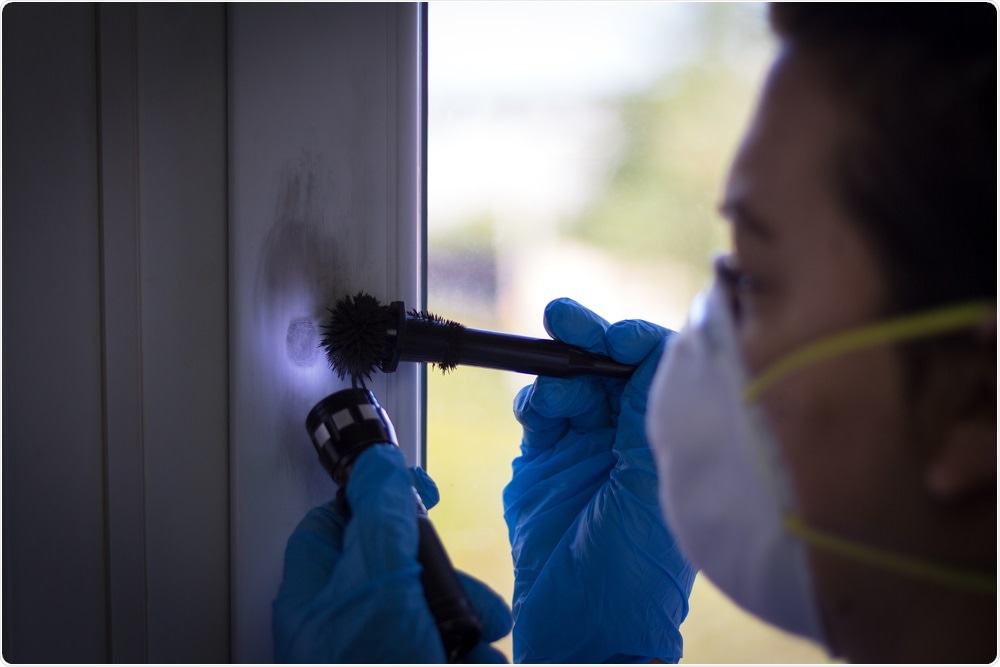In this interview, AZoLifeSciences speaks to Prof. Simona Francese about her latest research into fingermarks and how, by using MALDI-MS, you can determine the sex of the owner.
What provoked your research into forensics and the analysis of fingermarks?
I have always had a passion for forensics and trained in chemistry with the view of contributing one day to the field. In my first academic post as a lecturer, I had the opportunity to apply my expertise in analytical chemistry and mass spectrometry to forensics and, in particular, to fingermarks by which I had always been fascinated.

Fingermark left at crime scene. Image Credit: Zoka74/Shutterstock.com
Why have there been few developments in fingermark analysis over the last 100 years?
There have been many developments in forensics, and in fingerprinting, the development of more sensitive and effective visualization techniques have contributed to a higher number of detected and identifying fingermarks.
However, before 2009, the molecular content of fingermarks was only exploited to refine existing or develop new enhancement techniques but never to gain intelligence on the suspect leaving a fingermark behind. This is why I named the process of gaining intelligence around a suspect, exploiting the molecular content of their fingermarks, "chemical criminal profiling".
What role does mass spectrometry play within fingermark analysis?
Mass spectrometry enables the detection of a vast range of molecules. It does that by measuring the specific mass-to-charge (m/z) of the molecules and by confirming their identity by measuring the m/z of the fragments intentionally generated by breaking up the molecule.
These molecules may be of forensic interest (drugs, medications explosives, etc..). As such these compounds may provide intelligence on personal identifying information, an individual's lifestyle, and even suggest actions around the time the crime was committed.
Can you describe the difference between the term ‘fingerprint’ and ‘fingermark’?
The term fingerprint refers to ridge pattern impressions obtained under controlled conditions (e.g. at police stations, airports, etc.). The term fingermark refers to an accidental touch of the fingertip with a surface that leaves a ridge pattern impression.
Fingermark is therefore the term that is used to refer to this type of evidence when collected at crime scenes.
What is meant by the term ‘natural marks’?
This terminology refers to mock marks created in the lab by simply touching a surface without any washing or prior preparation of the fingertip surface. This is to mimic real scenarios of individuals accidentally touching a surface and leaving a mark. It is therefore realistic as opposed to other artificially created marks that lack some specific classes of chemical compounds.
Can you describe how you carried out your research into the sex determination of fingermarks?
We collected 2 sets of 172 natural fingerprints each from donors aged >18 years old. One set was enhanced using white indestructible CSI powder. All fingerprints were subjected to MALDI MS profiling. Here a laser in the UV region is fired upon the sample mixed with ionizing agents and mass spectra are collected in few seconds, enabling the detection of peptides and proteins in each fingerprint.
All of the mass spectra were subjected to extensive statistical analysis to identify the model enabling the classification of sex with the highest predictive power.
What role did MALDI MS play in this research?
MALDI was used to detect the peptides and small proteins within the fingermarks. These species are naturally produced by all of us and are present in sweat.
As the fingertip makes contact with the surface, a fingermark containing these species is generated.
What did you discover?
Biological males exhibit a distinct peptidic/protein profile, different from that exhibited by biological females. This enables classification of the two sexes within the 86% of accuracy from a fingermark.
We also discovered that this is possible from fingermarks that have been previously enhanced using a common CSI technique. This occurrence enables the method to be used at a real crime scene if that particular enhancement technique has been used.
How does the peptide and protein content of fingermarks differ between sexes?
The vast majority of the peptides and proteins detected and exploited for sex determination are present in both sexes' sweat. However, their relative abundance differs and it is this particular pattern that is used to make the classification.
Why is it important to be able to accurately identify the sex of fingermarks left at crime scenes?
Because it enables us to narrow down the pool of suspects by eliminating one sex.
In this case, our research will be used by the Police to triaging crime scene marks in a scenario where many need to be screened and a prioritizing method is necessary.
What are the next steps in your research?
Investigate with how many crime labs and CSI techniques this method of sex determination can be compatibly used and establish whether even more sensitive instrumentation can generate higher intensity signals for the species of interest, thus potentially increasing the predictive power of sex determination from fingermarks.
Both areas of investigation will support the implementation of this method in the field and aid investigations.
Where can readers find more information?
- Heaton C, Bury C., Patel E, Bradshaw R, Wulfert F, Heeren RM, Marchant L., Denison N, McColm R, Francese S. "Investigating sex determination through MALDI MS analysis of peptides and proteins in natural fingermarks through comprehensive statistical modeling" (2020) Forensic Chemistry, 20, 100271, https://doi.org/10.1016/j.forc.2020.100271
- Francese S., Bradshaw R., Denison N., "An update on MALDI Mass Spectrometry based technology for the analysis of fingermarks - stepping into operational deployment". (2017) Analyst, 142(14):2518-2546 https://doi.org/10.1039/C7AN00569E
About Professor Simona Francese
Simona Francese is Professor of Forensic and Bioanalytical Mass Spectrometry at Sheffield Hallam University, UK.
She holds a degree in Chemistry obtained from the University of Salerno, Italy, and a Ph.D. in Chemical Sciences awarded by the same University with one year spent at the University of Leeds, UK, thanks to a Marie Curie fellowship.
She is an expert in the development of MALDI MS Imaging applications and has pioneered its development for the analysis of latent fingermarks to profile offenders with >30 publications in the field.
More recently she has engaged in the development of MALDI MS-based methods for the robust detection, provenance, and mapping of blood in stains and marks.
Simona is the Lead of the Fingermark Research Group (FRG) and through the years her research has been partly funded by the Home Office and The Defence Science and Technology Laboratory, UK.
She actively collaborates with West Yorkshire Police and her research is being implemented in casework in the UK and Europe.
She is one of the 40 invited members of the International FRG and an invited member of the European Network of Forensic Sciences.
Since March 2017, she is the Chair of the COST Action CA16101 MULTi-modal imaging of FOREnsic SciEnce Evidence (MULTI-FORESEE)- tools for Forensic Science’.
She engages public dissemination at all levels and one recent endeavor was the delivery of a TED talk in Vancouver on molecular fingerprinting.